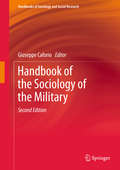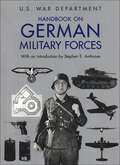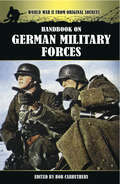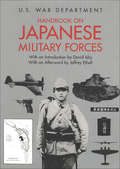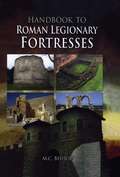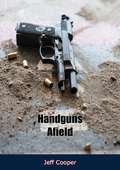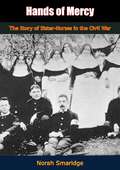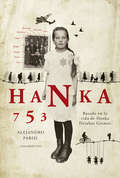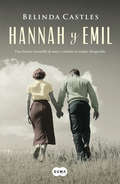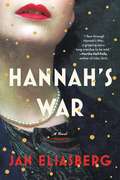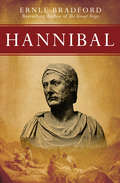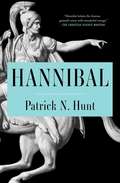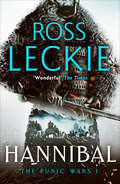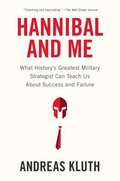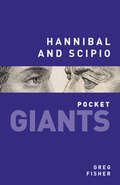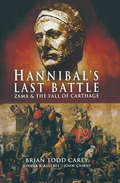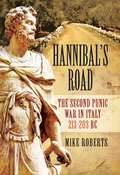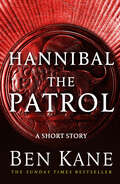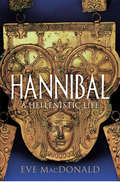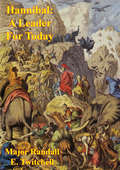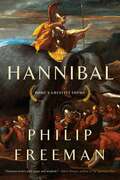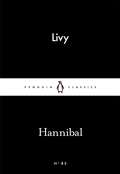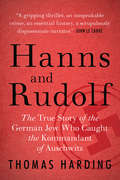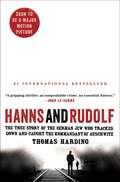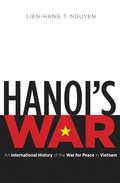- Table View
- List View
Handbook of the Sociology of the Military (Handbooks Of Sociology And Social Research Ser.)
by Giuseppe Caforio Marina NuciariThis new edition of the volume is presented on the wave of the success which had its first edition (2003). It is entirely updated to the current situation of the disciplines covered, and expanded with particular regard to the new missions, that have become the main challenge for the armed forces in these first decades of the new millennium, with new insights to technological development toward so-called cyborg warriors, new forms of leadership and changes in soldier's identity and organisational culture. It is compiled of documents coming from various researchers at universities around the world as well as military officers devoted to the sector of study. Covered in this volume is a historical excursus of studies prior to contemporary research, interpretive models and theoretical approaches developed specifically for this topic, civic-military relations including issues surrounding democratic control of the armed forces, military culture, professional training, conditions and problems of minorities in the armed forces, an examination of the structural change within the military over the years including new duties and functions following the Cold War.
Handbook on German Military Forces
by Stephen E. Ambrose U.S. War Department David I. NorwoodIn March, 1945, the U.S. War Department issued a restricted document called Handbook on German Military Forces. The restricted classification was removed in 1953, but the handbook has until now remained virtually unknown. The book is a massive compendium of information on every aspect of Hitler's forces. It gives credence to the contention that by 1945 U.S. Army Chief of Staff George C. Marshall may have known more about the German military than did Hitler himself. Exceptionally well organized and exhaustively detailed, the handbook examines German military personnel from the lowest levels to the High Command. It describes the Wehrmacht's administrative structure, unit organization, field tactics, fortification and defense systems, weapons and other equipment, and uniforms and insignia. Moreover, it presents this abundance of information in a manner that is remarkable for its depth and clarity. The book contains an astute analysis of the psychology of the German soldier and charts the ways in which the attitudes of Hitler's men changed over the course of the war. It also considers the strengths and weaknesses of the German weapons systems, describes how Allied soldiers could make use of captured weapons, and offers advice on how Allied military personnel might avoid being captured themselves. Hundreds of tables, organizational charts, and illustrations, some in color, add further value to the book. Handbook on German Military Forces will prove indispensable to scholars of World War II as well as to all devotees of military history.
Handbook on German Military Forces: Handbook On German Military Forces (World War II From Original Sources)
by Bob CarruthersThe Handbook On German Military Forces is an indispensable primary reference source for historians and enthusiasts. In 1945 the Allies were still engaged in bitter fighting against stiff resistance from the German armies in the west. The US War Department was determined to do its best to equip the US forces fighting the Germans in the field with as much knowledge as possible. March 1945 saw the issue of an astonishing document entitled the Handbook On German Military Forces. This was a truly remarkable work of intelligence gathering which formed a vast compendium of all the relevant knowledge amassed on the German Wehrmacht.Amazingly accurate and comprehensive, the Handbook ran to over six hundred pages and was designed to equip commanders in the field with everything they were likely to need to know about the German forces. The Handbook remained classified until 1953 and then slipped into obscurity.This new paperback reprint rescues this great work from obscurity, covering the psychology, organisation, tactics and operational aspects of the German forces. The weapons, machines, aircraft and uniforms of the German forces are also documented within the Handbook.The Handbook On German Military Forces is a fascinating primary reference source for historians and enthusiasts alike, providing an invaluable insight into the detail of the German Army which is still an unrivaled source of information today.
Handbook on Japanese Military Forces
by U.S. War Department Jeffrey Ethell David IsbeyIn 1944 the U.S. Army published this manual for its officers in the Pacific Theater an expanded version of the original 1942 manual of the same name--and ever since, it has been the best single reference source on the wartime Japanese military available in the English language. By 1944, the army had had time to assess its enemy closely and was coming to understand him, and its vast knowledge was distilled into the handbook. The handbook details the Japanese military system, field organization, tactics, and weapons and equipment, and the strengths and weaknesses that resulted from them. Extensively illustrated, it contains sections on the Japanese special forces, the military police, uniforms and insignia, and conventional signs and abbreviations. It covers, besides the army, the Japanese Air Service, with emphasis on its tactics and organization. Issued to officers for briefings and periodically updated, the handbook's purpose was to assist in the winning of the war, and thus it strove to be absolutely reliable for its users in combat. It was compiled by a team of officers who integrated the research of others, and it contains information provided by the U.S. Marines and also by British and Australian intelligence. Packed with information, it is a major primary source that military historians and World War II buffs will find fascinating.
Handbook to Roman Legionary Fortresses
by M.C. BishopAn extensive guide to the legionary fortresses of the Roman Empire, including locations, history, layout, and more. This is a reference guide to Roman legionary fortresses throughout the former Roman Empire, of which approximately eighty-five have been located and identified. With the expansion of the empire and the garrisoning of its army in frontier regions during the 1st century AD, Rome began to concentrate its legions in large permanent bases. Some have been thoroughly explored while others are barely known, but this book brings together for the first time the legionary fortresses of the whole empire. An introductory section outlines the history of legionary bases and their key components. At the heart of the book is a referenced and illustrated catalogue of the known bases, each with a specially prepared plan and an aerial photograph. A detailed bibliography provides up-to-date publication information. The book includes a website providing links to sites relevant to particular fortresses and a Google Earth file containing all of the known fortress locations.
Handguns Afield
by Jeff CooperWhen Handguns Afield was first published in 1961, hunting with a handgun was in its infancy. Surely settlers and cowboys of the 19th century would have used a handgun on wild game from time to time to fill the campfire stewpot, but as far as using a handgun for hunting as a pastime, this sport was not yet widely recognized.Author Jeff Cooper expertly summarizes the various aspects of hunting with handguns in the few dozen pages of this volume. Handguns, cartridges, holsters, and shooting small and large game are all thoroughly described and explained here. If the average handgun shooter follows the advice of this book—most of which is still relevant today—he will be prepared to hunt game with a pistol.“THE MAN who wants to take game with a pistol must realize that if he is to be successful he must be good. He must be a good woodsman, a good hunter, a good sportsman, and an extremely good shot. Because he cannot reach out as with a rifle, he must be able to get right up on his target, and this takes both knowledge of game and much stalking skill. The more open the country, the more skill is required. In thick brush the pistol is handier than the rifle, and the problem becomes one of moving-target marksmanship.“The pistol hunter is more agile than the rifleman, since he has both hands free to use in climbing or parting brush. For the same reason he may be quieter. These things help him in very rough, heavily wooded terrain. In fact, every aspect of hunting is easier for the handgunner than for the rifleman—except hitting. Therefore marksmanship is the big problem.”—Jeff Cooper
Hands of Mercy: The Story of Sister-Nurses in the Civil War
by Norah SmaridgeSix hundred nuns from twelve religious communities served as U.S. Army nurses during the Civil War. They served on the battlefield and gave their lives. A group of Sisters of Mercy traveling to St. Louis on a Union steamboat took fire from a Confederate gun battery and worked through it, tending the wounded. At Gettysburg one St. Joseph sister wiped the blood-covered face of a young soldier to discover that he was her 18 year-old brother.When the Sisters of Providence took over the military hospital in Indianapolis during the Civil War, they found that “it was dirty beyond belief. A scouring brigade was formed, and the nuns went down on their knees, scrubbing every inch of the stained and dirty floors. They washed walls and windows, threw out dirty mattresses, and soon had the wards clean and sweet-smelling. Next they set up kitchens, special diet kitchens, and a laundry.”Soldiers, doctors, military officials, civilians—all learned to respect and admire the Sisters, who came to be known as the Sisters of Charity.In the years following the Civil War, nuns established 800 hospitals, the basis for a network of Catholic hospitals that now serves one in six patients, the largest private group in the U.S.This wonderful book by Norah Smaridge provides a glorious in-depth portrait of the many Sister-Nurses during the Civil War years.
Hanka 753: Basado en la vida de Hanka Dziubas Grzmot
by Alejandro ParisiLa propuesta de un viaje enfrenta a Hanka con imágenes de un pasado que se propuso olvidar. La invasión alemana, el ghetto y luego Auschwitz cambiarán para siempre su mundo. La apasionante y cruel historia de una sobreviviente del horror. Polonia, 1939. La pequeña Hanka vive con sus seis hermanos y su padre hasta que, de pronto, la invasión alemana cambia para siempre su mundo. Recluida en su casa del ghetto y con tan solo nueve años, se pregunta qué es lo que están haciendo con los judíos. ¿Cómo saberlo, encerrada en esa casa donde sus dos hermanas la protegen de lo que ocurre allá afuera? El hambre, la soledad y el terror serán su sino durante cuatro años, hasta que finalmente sea deportada a Auschwitz con sus hermanas. Pasará treinta y seis horas frente a la puerta de ese horno infernal que se traga a los judíos sin que nadie detenga la barbarie nazi. Hanka crece descubriendo la oscura realidad y el pánico profundo que se expande por toda Europa. Entonces, por azar o designio divino, comenzará un derrotero por los distintos campos de trabajo y de aniquilación de Alemania, despertando en ella una fuerza inaudita que la empujará a sobrevivir a cada día sin más certezas que el abrazo de esas hermanas que sufren a su lado. Juntas enfrentarán el horror, con la esperanza de que el final de la guerra las encuentre unidas, convertidas en sobrevivientes de eso que años más tarde todos llamarán Holocausto.
Hannah y Emil
by Belinda CastlesUna historia irresistible de amor y valentía en tiempos desesperados. Emil, veterano alemán de la Primera Guerra Mundial, regresa a casa y se encuentra un país desquiciado. La inflación y el desempleo precipitan a Alemania hacia la catástrofe y la participación de Emil en la resistencia le obliga a abandonar su hogar y a su familia. Mientras tanto, en el West End londinense, Hannah es una joven y políglota judía rusa que, ansiosa por conocer mundo, decide viajar a Europa y recorre un continente abocado a la guerra total. En Bruselas conoce a un extenuado Emil, que acaba de cruzar la frontera a pie desde la Alemania nazi, donde la tragedia está cada vez más cerca. Durante un breve espacio de tiempo construyen una vida juntos en Inglaterra, antes de que estalle la guerra y Emil, por su condición de alemán, sea recluido y exiliado. Hannah, decidida a encontrarlo, emprende un viaje por mar solitario y lleno de peligros... Hannah y Emil es una historia conmovedora de valor y determinación impulsada por las poderosas corrientes de la historia. Un relato de amor duradero y coraje sin fin con el caos y la devastación de la II Guerra Mundial como telón de fondo. Reseñas:«En primer lugar y por encima de todo, esta es la historia verdadera -la de los abuelos de Castles- de dos personas que tuvieron que superar terribles obstáculos para poder vivir juntas y en paz. Quizá por esta razón consigue emocionar allí donde otras novelas se convierten en meros cuentos de hadas. Castles es una escritora llena de fuerza [...]. Y es que estas personas, Hannah y Emil, son tan reales que el lector queda cautivado por ellas y no puede evitar desear que su historia tenga un final feliz. En tercer lugar, el libro está excelentemente documentado. Los detalles de las penalidades de los prisioneros de guerra, soldados, mujeres, refugiados, disidentes y supervivientes están narrados con emoción y talento».Readings «Basada en las vidas de los abuelos de su autora, Hannah y Emil constituye un espléndido relato de amor verdadero con la II Guerra Mundial como telón de fondo».Good Reads «Una novela apasionante y un afectuoso retrato de dos idealistas forzados a enfrentarse a las duras elecciones que plantea la historia».The Newtown Review of Books. «Una conmovedora historia de amor, coraje y convicción marcada por las poderosas corrientes de la historia».Booktopia «Una novela ambiciosa que se centra en el aquí y ahora, en las dificultades inmediatas de la vida cotidiana. El sentimentalismo al que podría haber sucumbido teniendo en cuenta los hechos que relata se evita por completo y en su lugar surge un relato claro, absorbente y pleno de inteligencia».SMH «Una historia atemporal de amor y valentía llena de esperanza e inspiración».Get Reading «Es una novela construidaa partir de cartas, diarios y recuerdos familiares reales que la vívida imaginación de su autora ha sabido combinar con talento. [...] Narra una historia única de valentía, amor, pérdida y añoranza [...]. Es una novela de la queCastles puede sentirse orgullosa y una hermosa manera de rendir homenaje a sus extraordinarios abuelos».Book'd Out «El ritmo no decae en ningún momento y el lector tiene al terminar la sensación de haber viajado tanto como sus protagonistas. Los aficionados a la novela histórica disfrutarán de este libro que celebra la experiencia cotidiana de construir una vida con alguien, pero también la hazaña extraordinaria que supone superar grandes obstáculos en la vida».Blog de Fanny Goods
Hannah's War
by Jan EliasbergA "mesmerizing" re-imagination of the final months of World War II (Kate Quinn, author of The Alice Network), Hannah's War is an unforgettable love story about an exceptional woman and the dangerous power of her greatest discovery.Berlin, 1938. Groundbreaking physicist Dr. Hannah Weiss is on the verge of the greatest discovery of the 20th century: splitting the atom. She understands that the energy released by her discovery can power entire cities or destroy them. Hannah believes the weapon's creation will secure an end to future wars, but as a Jewish woman living under the harsh rule of the Third Reich, her research is belittled, overlooked, and eventually stolen by her German colleagues. Faced with an impossible choice, Hannah must decide what she is willing to sacrifice in pursuit of science's greatest achievement.New Mexico, 1945. Returning wounded and battered from the liberation of Paris, Major Jack Delaney arrives in the New Mexican desert with a mission: to catch a spy. Someone in the top-secret nuclear lab at Los Alamos has been leaking encoded equations to Hitler's scientists. Chief among Jack's suspects is the brilliant and mysterious Hannah Weiss, an exiled physicist lending her talent to J. Robert Oppenheimer's mission. All signs point to Hannah as the traitor, but over three days of interrogation that separate her lies from the truth, Jack will realize they have more in common than either one bargained for. Hannah's War is a thrilling wartime story of loyalty, truth, and the unforeseeable fallout of a single choice.
Hannibal
by Ernle BradfordThe life of the great military commander of ancient Carthage from the bestselling author of Thermopylae and Gibraltar. Born in Carthage in 247 BC, Hannibal Barca is considered one of the greatest military commanders of all time. Following the example set by his father, Hamilcar, he dedicated his life to the defeat of Rome. At the outbreak of the Second Punic War, Hannibal famously led an army across the Pyrenees and the Alps to victory against the Romans at the Battle of Trebia. In the years that followed, Hannibal led the Carthaginian war on Rome through some of the most brutal and costly battles in recorded history. In this richly detailed biography, Ernle Bradford tells the story of a great leader whose military strategies have been studied and copied by commanders throughout history, from his own Roman enemies to Napoleon Bonaparte.
Hannibal
by Patrick N HuntHannibal is &“an exciting biography of one of history&’s greatest commanders…a thrilling page-turner&” (Kirkus Reviews, starred review) about the brilliant general who successfully crossed the Alps with his war elephants and brought Rome to its knees, and who is still regarded today as one of the greatest military strategists in history.Hannibal Barca of Carthage, born 247 BC, was one of the great generals of the ancient world. His father, Hamilcar, imposed Carthaginian rule over much of present-day Spain. After Hamilcar led the Carthaginian forces against Rome in the First Punic War, Hannibal followed in his father&’s footsteps. From the time he was a teenager, Hannibal fought against Rome. He is famed for leading Carthage&’s army across North Africa, into Spain, along the Mediterranean coast, and then crossing the Alps with his army and war elephants. Hannibal won victories in northern Italy by outmaneuvering his Roman adversaries and defeated a larger Roman army at the battle of Cannae in 216 BC. Unable to force Rome to capitulate, however, he was eventually forced to leave Italy and return to Carthage when a savvy Roman general named Scipio invaded North Africa. Hannibal and Scipio fought an epic battle at Zama, which Hannibal lost. Many Carthaginians blamed Hannibal, who was exiled until his death. Hannibal is still regarded as a military genius. Napoleon, George Patton, and Norman Schwarzkopf, Jr. are only some of the generals who studied and admired him. His strategy and tactics are still taught in military academies. &“With wonderful energy…archeologist and historian Patrick Hunt distills his survey of literature about the Second Punic War into a brightly dramatic story that covers virtually every anecdote connected with Hannibal&” (The Christian Science Monitor). &“Hunt&’s story of the doomed general, whose exploits are more celebrated than those of his vanquishers, will appeal to any reader interested in military history or strategy&” (Publishers Weekly).
Hannibal (The Punic Wars)
by Ross LeckieThe third century BCE: One man will bring an empire to its knees.The wars between Rome and Carthage will see some of the most bloody and savage battles of all time. Hundreds of thousands will die, and Rome will win mastery of the known world.Amid this, a figure will emerge who has become the stuff of myth and legend: Hannibal Barca.In this breathtaking chronicle of love and hate, heroism and cruelty, one of history’s greatest generals returns to life. Hannibal learns, through suffering, that man is but a shadow of a dream.A scintillating, blood-soaked tale of loss and victory, this is a masterful piece of historical fiction, perfect for fans of Simon Scarrow, Conn Iggulden and Ian Ross.Praise for Hannibal‘Wonderful … what was once cold history becomes full-bodied adventure’ The Times‘Leckie writes unflinchingly of this world of blood, battle and atrocity’ Sunday Telegraph‘Its triumph is to bring the world of Carthage to life again’ Spectator
Hannibal and Me: What History's Greatest Military Strategist Can Teach Us About Success and Failure
by Andreas KluthA dynamic and exciting way to understand success and failure, through the life of Hannibal, one of history's greatest generals. The life of Hannibal, the Carthaginian general who crossed the Alps with his army in 218 B. C. E. , is the stuff of legend. And the epic choices he and his opponents made-on the battlefield and elsewhere in life-offer lessons about responding to our victories and our defeats that are as relevant today as they were more than 2,000 years ago. A big new idea book inspired by ancient history, Hannibal and Me explores the truths behind triumph and disaster in our lives by examining the decisions made by Hannibal and others, including Albert Einstein, Eleanor Roosevelt, Steve Jobs, Ernest Shackleton, and Paul Cézanne-men and women who learned from their mistakes. By showing why some people overcome failure and others succumb to it, and why some fall victim to success while others thrive on it, Hannibal and Me demonstrates how to recognize the seeds of success within our own failures and the threats of failure hidden in our successes. The result is a page-turning adventure tale, a compelling human drama, and an insightful guide to understanding behavior. This is essential reading for anyone who seeks to transform misfortune into success at work, at home, and in life. .
Hannibal and Scipio: pocket GIANTS
by Greg FisherIn 218, Hannibal Barca, desperate to avenge the defeat of Carthage in the First Punic War, launched an ambitious ground invasion of Italy. With just a small force, he crossed the Alps – a feat reckoned to be impossible – and pitted his polyglot army against Rome’s elite citizen infantry. At Cannae, in 216, Hannibal destroyed an 80,000-strong Roman force in one afternoon, delivering a blow unequalled in Roman history for half a millennium to come.The Romans had no answer to Hannibal until the young Scipio volunteered to take over Rome’s armies in Spain, which were close to defeat, and left leaderless by the death of Scipio’s own father and uncle. In the decade which followed, Scipio turned Rome’s desperate fortunes into a stunning victory over Carthage. The portrait of Hannibal and Scipio takes the reader through one of the greatest military campaigns in history, driven by two remarkable and fascinating men.
Hannibal's Last Battle: Zama & The Fall of Carthage
by John Cairns Brian Todd Carey Joshua B. AllfreeA &“crisply written, well researched . . . superb piece of scholarship about one of the most dramatic and decisive battles in the ancient world&” (Journal of Military History). At Zama (in what is now Tunisia) in 202 BC, the armies of two great empires clashed: the Romans under Scipio Africanus and Carthaginians, led by Hannibal. Scipio&’s forces would win a decisive, bloody victory that forever shifted the balance of power in the ancient world. Thereafter, Rome became the dominant civilization of the Mediterranean. Here, Brian Todd Carey recounts that battle and the grueling war that led up to it. He offers fascinating insight into the Carthaginian and Roman methods of waging war, their military organizations, equipment, and the tactics the armies employed. He also delivers an in-depth critical assessment of the contrasting qualities and leadership styles of Hannibal and Scipio, the two most celebrated commanders of their age. With vivid prose and detailed maps of the terrains of the time, Hannibal&’s Last Battle is an essential text for fans of military history and students of the classical period.
Hannibal's Road: The Second Punic War in Italy, 213–203 BC
by Mike RobertsMany books have been written on the Second Punic War and Hannibal in particular but few give much space to his campaigns in the years from 213 203 BC. Most studies concentrate on Hannibals series of stunning victories in the early stages of the war, culminating at Cannae in 216 BC, then refocus on the activities of his nemesis ,Scipio Africanus, in Spain until the two meet in the final showdown at Zama. But this has led to the neglect of some of the Carthaginian genius most remarkable campaigns. By 212 the wider war was definitely going against the Carthaginians. Yet Hannibal, despite being massively outnumbered and with little support from home, was able to sustain his polyglot army and campaign actively across southern Italy for another ten years. His skilful manoeuvring and victory in numerous engagements kept several veteran armies of the normally aggressive Romans tied up and on the defensive, until Scipios invasion of North Africa pulled him home to defend Carthage. Mike Roberts follows the course of these remarkable events in detail, analysing Hannibals strategy and aims in this phase of the war and revealing a genius that had lost none of its lustre in adversity.
Hannibal: (Short Story)
by Ben KaneAn exclusive straight to digital short story which also includes the first chapter of Ben Kane's Hannibal: Fields of Blood. WINTER 218 BCIn Cisalpine Gaul, a Carthaginian patrol is moving stealthily through thick woodland.It’s led by Hanno, one of Hannibal’s young officers, and his second-in-command Mutt. Famished and cold, they are making for a town full of the grain that they desperately need.But the local Gauls cannot be trusted; and although defeated, the Romans still have patrols in the area. With peril on every side and a deadly ambush ahead, there is no certainty that either Hanno or Mutt will survive ...
Hannibal: A Hellenistic Life
by Eve MacDonaldThe life of the great Carthaginian general who marched into Rome during the Second Punic War is reexamined in this revealing and scholarly biography. Once of the greatest military minds of the Ancient World, Hannibal Barca lived a life of daring and survival, massive battles, and ultimate defeat. A citizen of Carthage and military commander in Punic Spain, he famously marched his war elephants and huge army over the Alps into Rome&’s own heartland to fight the Second Punic War. Yet the Romans were the ultimate victors. They eventually captured and destroyed Carthage, and thus it was they who wrote the legend of Hannibal: a brilliant and worthy enemy whose defeat represented military glory for Rome. In this groundbreaking biography, Eve MacDonald employs archaeological findings and documentary sources to expand the memory of Hannibal beyond his military career. Considering him in the context of his time and the Carthaginian culture that shaped him, MacDonald offers a complex portrait of a man from a prominent family who was both a military hero and a statesman. MacDonald also analyzes Hannibal&’s legend over the millennia, exploring how statuary, Jacobean tragedy, opera, nineteenth-century fiction, and other depictions illuminate the character of one of the most fascinating figures in all of history.
Hannibal: A Leader For Today
by Major Randall E. TwitchellThis study reviews the life, battles, and campaigns of the Carthaginian General Hannibal while attempting to illustrate the leadership values and primary characteristics of Hannibal that contributed to his success on the battlefield. Hannibal won extraordinary victories against his opponents (primarily Romans), and usually against overwhelming odds, with a mercenary army composed of many different nations. This study demonstrates that Hannibal was one of the "Great Captains" of the past and, more importantly, that studying his life today has great relevance for modern soldiers. The leadership values of Hannibal are core values that to one extent or another can be found in all great leaders of both the past and present. This study concludes by identifying Hannibal's finest leadership values and characteristics, then demonstrating their relevancy by comparing them with current United States Army doctrine, and by showing these values through examples in the lives of nineteenth century and twentieth century U. S. military leaders. Thus the purpose of this study is to demonstrate that the lives of leaders, such as Hannibal (who lived 2,000 years ago), have relevance to military leaders today and the application of their leadership values and characteristics can produce success on the battlefield.
Hannibal: Rome's Greatest Enemy
by Philip FreemanTelling the story of a man who stood against the overwhelming power of the mighty Roman empire, Hannibal is the biography of a man who, against all odds, dared to change the course of history. Over two thousand years ago one of the greatest military leaders in history almost destroyed Rome. Hannibal, a daring African general from the city of Carthage, led an army of warriors and battle elephants over the snowy Alps to invade the very heart of Rome's growing empire. But what kind of person would dare to face the most relentless imperial power of the ancient world? How could Hannibal, consistently outnumbered and always deep in enemy territory, win battle after battle until he held the very fate of Rome within his grasp? Hannibal appeals to many as the ultimate underdog—a Carthaginian David against the Goliath of Rome—but it wasn't just his genius on the battlefield that set him apart. As a boy and then a man, his self-discipline and determination were legendary. As a military leader, like Alexander the Great before him and Julius Caesar after, he understood the hearts of men and had an uncanny ability to read the unseen weaknesses of his enemy. As a commander in war, Hannibal has few equals in history and has long been held as a model of strategic and tactical genius. But Hannibal was much more than just a great general. He was a practiced statesman, a skilled diplomat, and a man deeply devoted to his family and country. Roman historians—on whom we rely for almost all our information on Hannibal—portray him as a cruel barbarian, but how does the story change if we look at Hannibal from the Carthaginian point of view? Can we search beneath the accounts of Roman writers who were eager to portray Hannibal as a monster and find a more human figure? Can we use the life of Hannibal to look at the Romans themselves in an unfamiliar way— not as the noble and benign defenders of civilization but as ruthless conquerors motivated by greed and conquest?
Hannibal: The History Of Rome From Its Foundation Books 21-30 (Penguin Little Black Classics)
by Livy'We have nothing left in the world but what we can win with our swords.'The remarkable account of Hannibal crossing the Alps with his elephants and winning the Battle of the Trebbia.One of 46 new books in the bestselling Little Black Classics series, to celebrate the first ever Penguin Classic in 1946. Each book gives readers a taste of the Classics' huge range and diversity, with works from around the world and across the centuries - including fables, decadence, heartbreak, tall tales, satire, ghosts, battles and elephants.
Hanns and Rudolf: The True Story of the German Jew Who Caught the Kommandant of Auschwitz
by Thomas HardingShortlisted for the 2013 Costa Biography Award. Part history, part biography, part true crime, Hanns and Rudolf chronicles the untold story of the Jewish investigator who pursued and captured one of Nazi Germany’s most notorious war criminals.May 1945. In the aftermath of the Second World War, the first British War Crimes Investigation Team is assembled to hunt down the senior Nazi officials responsible for the greatest atrocities the world has ever seen. One of the lead investigators is Lieutenant Hanns Alexander, a German Jew now serving in the British Army. Rudolf Höss is his most elusive target. As Kommandant of Auschwitz, Höss not only oversaw the murder of more than one million men, women, and children, but he perfected Hitler’s programme of mass extermination. On the run across a continent in ruins, Höss is the one man whose testimony can ensure justice at Nuremberg. Hanns and Rudolf reveals for the very first time the full, exhilarating account of Höss’s capture, an encounter with repercussions that echo to this day. Moving from the Middle-Eastern campaigns of the First World War to bohemian Berlin in the 1920s to the horror of the concentration camps and the trials in Belsen and Nuremberg, it tells the story of two German men — one Jewish, one Catholic — whose lives diverged, and intersected, in an astonishing way.
Hanns and Rudolf: The True Story of the German Jew Who Tracked Down and Caught the Kommandant of Auschwitz
by Thomas HardingINTERNATIONAL BESTSELLER The &“compelling,&” untold story of the man who captured and brought to trial Rudolf Höss—one of Nazi Germany&’s most notorious war criminals and subject of the Oscar-nominated film The Zone of Interest—&“fascinates and shocks&” (The Washington Post).May 1945. In the aftermath of the Second World War, the first British War Crimes Investigation Team is assembled to hunt down the senior Nazi officials responsible for the greatest atrocities the world has ever seen. One of the lead investigators is Lieutenant Hanns Alexander, a German Jew who is now serving in the British Army. Rudolf Höss is his most elusive target. As Kommandant of Auschwitz, Höss not only oversaw the murder of more than one million men, women, and children; he was the man who perfected Hitler’s program of mass extermination. Höss is on the run across a continent in ruins, the one man whose testimony can ensure justice at Nuremberg. Hanns and Rudolf reveals for the very first time the full, exhilarating account of Höss’s capture, an encounter with repercussions that echo to this day. Moving from the Middle Eastern campaigns of World War I to bohemian Berlin in the 1920s to the horror of the concentration camps and the trials in Belsen and Nuremberg, it tells the story of two German men—one Jewish, one Catholic—whose lives diverged, and intersected, in an astonishing way. This is “one of those true stories that illuminates a small justice in the aftermath of the Holocaust, an event so huge and heinous that there can be no ultimate justice” (New York Daily News).
Hanoi's War
by Lien-Hang T. NguyenWhile most historians of the Vietnam War focus on the origins of U.S. involvement and the Americanization of the conflict, Lien-Hang T. Nguyen examines the international context in which North Vietnamese leaders pursued the war and American intervention ended. This riveting narrative takes the reader from the marshy swamps of the Mekong Delta to the bomb-saturated Red River Delta, from the corridors of power in Hanoi and Saigon to the Nixon White House, and from the peace negotiations in Paris to high-level meetings in Beijing and Moscow, all to reveal that peace never had a chance in Vietnam.Hanoi's War renders transparent the internal workings of America's most elusive enemy during the Cold War and shows that the war fought during the peace negotiations was bloodier and much more wide ranging than it had been previously. Using never-before-seen archival materials from the Vietnam Ministry of Foreign Affairs, as well as materials from other archives around the world, Nguyen explores the politics of war-making and peace-making not only from the North Vietnamese perspective but also from that of South Vietnam, the Soviet Union, China, and the United States, presenting a uniquely international portrait.
